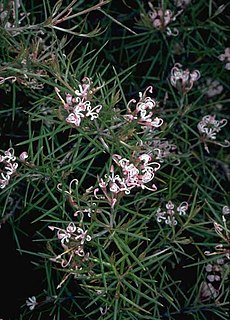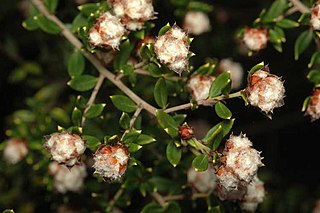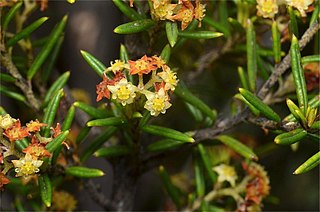
Spyridium parvifolium, commonly known dusty miller, is a flowering plant in the family Rhamnaceae. It has dark green leaves and clusters of small, whitish flowers at the end of branches. It is widespread in eastern states of Australia.

Persoonia mollis, commonly known as soft geebung, is a plant in the family Proteaceae and is endemic to New South Wales. It is an erect to prostrate shrub with linear to oblong or spatula-shaped leaves, yellow flowers in groups of up to thirty on a rachis up to 150 mm (5.9 in) long and relatively small fruit.
Hibbertia angulata is a species of flowering plant in the family Dilleniaceae and is endemic to a restricted area in the Northern Territory. It is an erect sub-shrub with sessile, linear leaves and yellow flowers arranged singly in leaf axils, with seventeen to nineteen stamens arranged in bundles around the three carpels.
Hibbertia cinerea is a species of flowering plant in the family Dilleniaceae and is endemic to the southern part of the Eyre Peninsula in South Australia. It is a densely-branched, hairy shrub with narrow elliptic to lance-shaped leaves, and yellow flowers arranged on the ends of branchlet, with nine to twelve stamens arranged in a group on one side of the two carpels.

Grevillea halmaturina is a species of flowering plant in the family Proteaceae and is endemic to South Australia. It is a prickly, spreading to erect shrub with sharply-pointed, linear to more or less-cylindrical leaves and large groups of white to pale pink flowers.

Pultenaea trinervis, commonly known as three-nerved bush-pea, is a species of flowering plant in the family Fabaceae and is endemic to the south-east of South Australia. It is a low, prostrate to erect shrub with hairy, elliptic to lance-shaped leaves and yellow to orange and red, pea-like flowers.
Pultenaea vestita, commonly known as feather bush-pea, is a species of flowering plant in the family Fabaceae and is endemic to south-western continental Australia. It is an erect to prostrate, sometimes mat-forming shrub with elliptic to linear or lance-shaped leaves, and yellow and red, pea-like flowers.

Spyridium burragorang, is a flowering shrub in the family Rhamnaceae. It has dense clusters of whitish flowers at the end of branches, alternate leaves and is endemic to New South Wales.

Pomaderris discolor is a species of flowering plant in the family Rhamnaceae and is endemic to south-eastern continental Australia. It is a shrub with woolly-hairy stems, elliptic leaves, and clusters of pale yellowish flowers.

Pomaderris ledifolia, commonly known as Sydney pomaderris, is a species of flowering plant in the family Rhamnaceae and is endemic to south-eastern continental Australia. It is an erect, delicate shrub with hairy young stems, narrowly elliptic to lance-shaped leaves, and compact clusters of yellow flowers.

Pomaderris ligustrina, commonly known as privet pomaderris, is a species of flowering plant in the family Rhamnaceae and is endemic to south-eastern continental Australia. It is a shrub with hairy stems, lance-shaped to narrowly elliptic leaves, and loose clusters of cream-coloured or yellow flowers.

Pomaderris obcordata, commonly known as wedge-leaved pomaderris, is a species of flowering plant in the family Rhamnaceae and is endemic to South Australia. It is a shrub with densely hairy branchlets, wedge-shaped, narrowly egg-shaped or heart-shaped leaves with the narrower end towards the base, and white to pink flowers.
Pomaderris virgata, commonly known as upright pomaderris, is a species of flowering plant in the family Rhamnaceae and is endemic to south-eastern continental Australia. It is an erect, slender shrub with hairy branchlets, lance-shaped, narrowly elliptic or oblong leaves, and dense panicles of golden-yellow flowers.
Pomaderris viridis is a species of flowering plant in the family Rhamnaceae and is endemic to south-eastern continental Australia. It is a shrub or small tree with hairy young stems, egg-shaped to elliptic leaves, and panicles of cream-coloured to pale yellowish-green flowers.

Spyridium bifidum, commonly known as forked spyridium, is a species of flowering plant in the family Rhamnaceae and is endemic to South Australia. It is an erect shrub with densely softly-hairy young stems, wedge-shaped to linear leaves sometimes with a two-lobed tip, and densely woolly heads of white-velvety flowers.

Spyridium buxifolium is a species of flowering plant in the family Rhamnaceae and is endemic to New South Wales. It is a spreading shrub with egg-shaped to elliptic leaves, and heads of white, softly-hairy flowers with brown bracts at the base of the heads.

Spyridium scortechinii is a species of flowering plant in the family Rhamnaceae and is endemic to eastern Australia. It is a shrub with egg-shaped to narrowly elliptic leaves, and dense heads of white, woolly-hairy flowers with brown bracts at the base.
Spyridium coalitum is a species of flowering plant in the family Rhamnaceae and is endemic to Kangaroo Island in South Australia. It is a slender, erect shrub with softly-hairy young stems, oblong to narrowly elliptic leaves, and head of white to cream-coloured flowers.

Spyridium daltonii is a species of flowering plant in the family Rhamnaceae and is endemic to Victoria in Australia. It is a shrub with softly-hairy branchlets, linear to narrowly elliptic leaves, and small groups of hairy, yellowish flowers.

Spyridium eriocephalum, commonly known as heath spyridium or heath dustymiller, is a species of flowering plant in the family Rhamnaceae and is endemic to south-eastern Australia. It is an erect to spreading shrub with linear leaves, and heads of white or cream-coloured, woolly-hairy flowers with brown bracts at the base.













